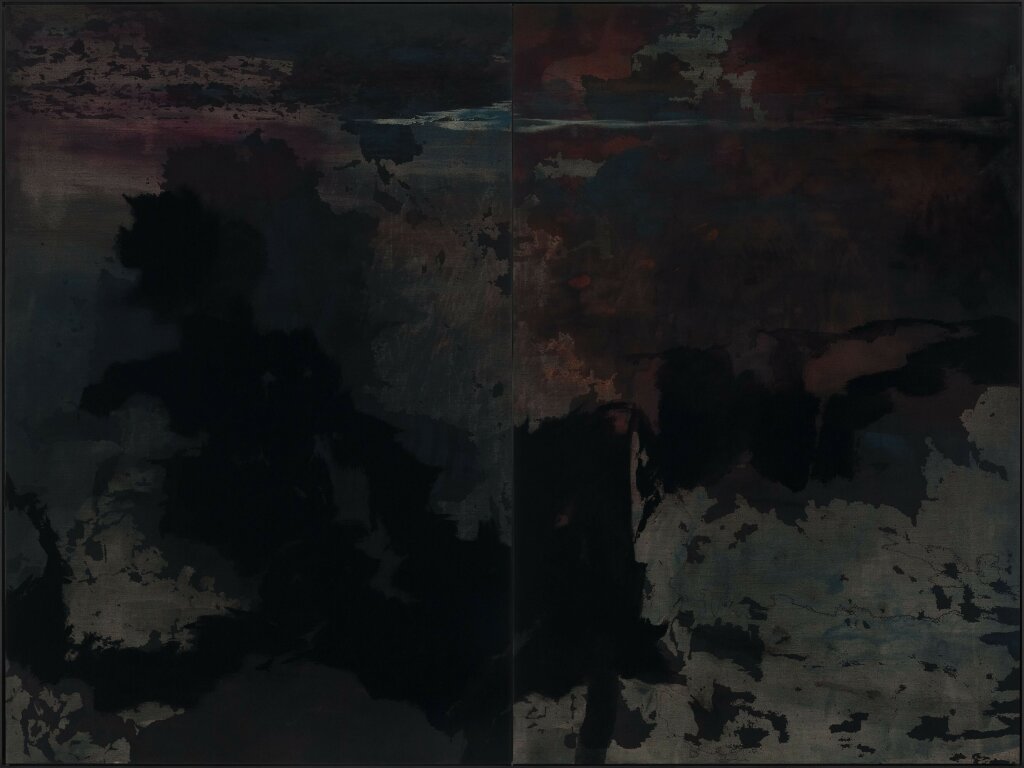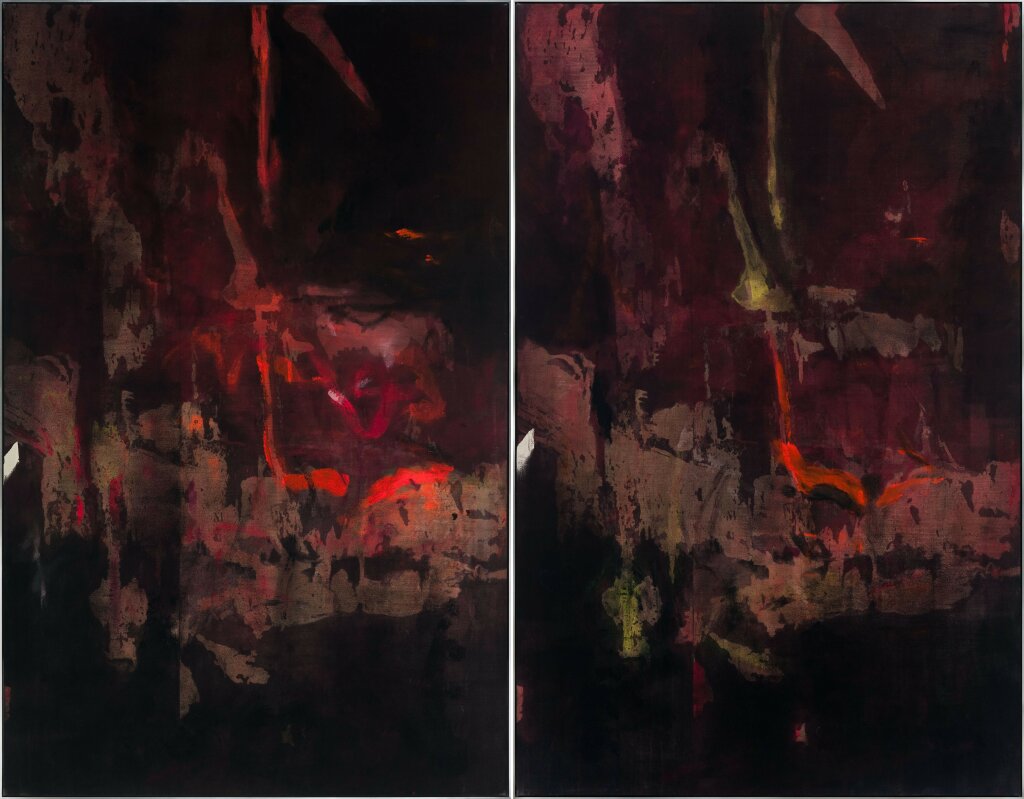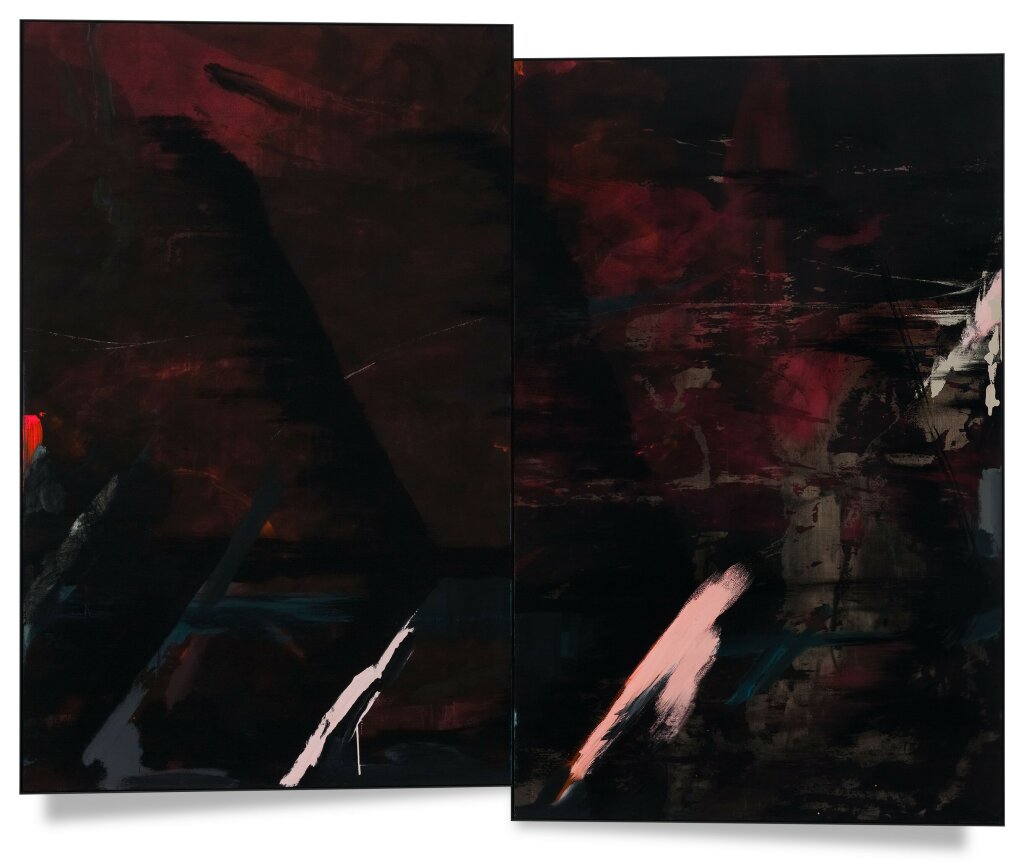What all the works of the series have in common is that their motifs are generated from the large-format work Der geschenkte Tag [The Given Day] (2021–2022), which thus finds its way into the individual works of the Hades series as pictorial information and forms a connecting element between the works themselves. Apart from Aides-Olymp Schwebebahn GmbH [Aides Olympus Suspension Railway Ltd.] (2022), which exists as two separate pictures, but which are linked by the identical supertitle as well as in terms of content, the entire series consists of diptychs. Some of these, such as Tyndareos’ Überfahrt (Widerspruch zur Wirklichkeit) [Tyndareos’ Passage (Contradiction to Reality)] (2022), are installed in angled frames that protrude from the wall at the outer ends—identical to the series Schwierige Bilder [Difficult Pictures]. The doubling of the image motif printed directly on the canvas on the left and right parts of the picture reveals the close links between the two sides, but also deviations, as the motifs can be digitally processed, mirrored or distorted. In a further step, they were revised by using painterly means, resulting in variations but also a dialogue between the panels.
Plutonion (european platinum dub remix) (2022) alludes in its title to the caves called Plutonion, which in ancient times were dedicated as a sanctuary to the god Pluton, the Roman name of the god of the underworld Hades. In these places, subterranean toxic gases often emanated, producing hallucinatory dreams: thus, in the middle of the two paintings, the silhouette of the celestial body Pluto, named after the god, appears shadowy like a phantasm through the mirroring of the motif. Epiklese (2022) also draws attention to the linking of deities with concrete empirical phenomena and objects, such as planets: the term epiclesis is understood to mean, on the one hand, the invocation of a god, for example in prayer, but also the epithet or cult name of a god, which emphasises particular aspects and characteristics of the respective god or expresses his connection with a particular place: Zeus and Hephaestus, for example, were worshipped in the vicinity of the volcano Etna as Aitnaios, whereby the abstract deities were individualised and thus became tangible for the people in very concrete life situations, for example as bringers of disaster during a volcanic eruption.
Closely linked in content and form are the two works Radar Discothèque (2022) and → ↔ ← Zeitpfeile, hänge ich am Haken? [→ ↔ ← Time arrows, am I on the hook?] (2022), which deal in different ways with the motif of steps, symbolising the descent into the underworld as well as the artist‘s privilege of returning from it to tell of it—like the singer Orpheus, who went to the underworld to save his beloved Eurydice and seduced the god Hades himself with his song, or the Italian poet Dante, whose Divine Comedy tells of his journey through the seven circles of hell. Whereas in Radar Discothèque the step is found as a motif in the painting itself through the offset of the gestural painting between the separate canvases, created by hanging the works at different heights in the painting process, in → ↔ ← Zeitpfeile, hänge ich am Haken? the offset hanging of the framed works, with the left painting hanging higher than the right, forms a physical step in the real world. The latter work refers to the fact, which the title also suggests, that time only progresses in one direction and that with death there is no going back in time—through memories, for example—since the souls drink from the river of oblivion before entering the realm of the dead, must henceforth live in the eternal present and are free of longings, expectations, hopes. The black arrows shown in the painting—painted in the darkest commercially available black that swallows almost the entire light spectrum—refer to the one-dimensionality of time and, through the implied barbs, to the impossibility of turning back. Here, moreover, the different conceptual approach to Der geschenkte Tag becomes clear, in which different layers of time overlap, for example, by reproducing photographic documentation of already painted areas as an underprint elsewhere on the canvas, and the artist thus moved back and forth along the time axis in the painting process.
Particularly closely linked to the Dioscuri myth are the works Tyndareos’ Überfahrt (Widerspruch zur Wirklichkeit) (2022), Kastor und Polydeukes [Castor and Polydeuces] (2022) and the two works with the supertitle Aides-Olymp Schwebebahn GmbH [Aides-Olympus Suspension Railway Ltd.] (2022). The twins Castor and Polydeuces were conceived in one night by different fathers as sons of Leda. Polydeuces, begotten by Zeus, is immortal as a demigod, while Castor, begotten by Tyndareus, is mortal. Slain in a battle, Castor descends into the realm of the dead. Polydeuces, struck by the loss of his brother, begs Zeus to take away his immortality so that he can be reunited with Castor in Hades. Touched by the twins‘ love, the father of the gods henceforth gives them the opportunity to spend alternate days together in Hades and on Olympus among the gods. Tyndareos’ Überfahrt (Widerspruch zur Wirklichkeit) represents a diptych and brings Castor‘s mortal father into the foreground. The pictorial motifs printed directly onto the canvas of the two panels of the painting, which were subsequently processed by Müller using painterly means, are mirrored, with the right-hand part of the picture being digitally compressed and distorted. In Kastor und Polydeukes (2022), one of the compositionally almost identical parts of the painting symbolically represents one of the brothers—they differ, however, in their colours. The right-hand part, which depicts the immortal Polydeuces, is extended by one colour and thus indicates his greater abundance of qualities: A golden yellow, which in medieval colour theory symbolised the sun and the divine and for this reason was reserved for the first estate. By combining ancient Greek myth and medieval Central European colour symbolism, the painting plays with historical time levels and geographical locations and points out that the basic structure of the myth of the Dioscuri can be found in different places at different times: For example, also in the Vedic mythology of Hinduism in the story about the divine twins Ashvin, the brothers Dasra and Nasatya, but also in the story about the Dieva dēli, the sons of the god of heaven, in pre-Christian Baltic mythology
The two works with the joint title Aides-Olymp Schwebebahn GmbH (2022) are, in contrast to the rest of the works in the series, linked to each other, but do not form a diptych. The subtitles indicate that they thematically deal with the day that Castor and Polydeuces spend alternately in Hades (Aides) and in Olympus—the daily journey to hell and rapture into the heaven of the gods. The paintings also pick up on the ‘uphill and downhill journey’ in their subtitles, which, through the insertion of footnotes, allows the reader’s gaze to wander back and forth on the paper between the continuous text and the footnotes at the bottom of the page: Teil 1. Bergfahrt (Olympischer Milchregen)¹ and Teil 2. Bergfahrt (Bilder, nichts als Bilder, kein Leben)² [Part 1. mountain journey (Olympic milk rain)¹ and Part 2. mountain journey (paintings, nothing but paintings, no life)²] (both 2022). In Hades all living things have passed away and there are only frozen images, the colours are covered by the dominating darkness in the second part. In the following ‘Mountain Journey’ of the Dioscuri in the first part, which shows the same but mirrored pictorial motif, the darkness is removed and overlit by white—at the same time an allusion to the divinity-giving power of Hera’s mother’s milk and the impact of Johann Joachim Winkelmann, the founder of classicism, on the idea of antiquity, which is given in the subtitle and still resonates today. Despite the knowledge of ancient polychromy, the colouring of Greek sculptures, confirmed by archaeological finds, Winkelmann held the view of ‘white’ antiquity, the ideal conception of pure, idealised sculpture: pure, white, immaculate and untouchable.
¹ Alternativer Titel: “vor Augen gestellt—das Winkelmann’sche Drehmoment oder das Begreifen hormoneller Schwankungen” [Alternative title: “Facing the eye—Winkelmann’s torque or grasping hormonal fluctuations”]
² Andere Farb- und Mengenverhältnisse [Other colour and quantity ratios]







